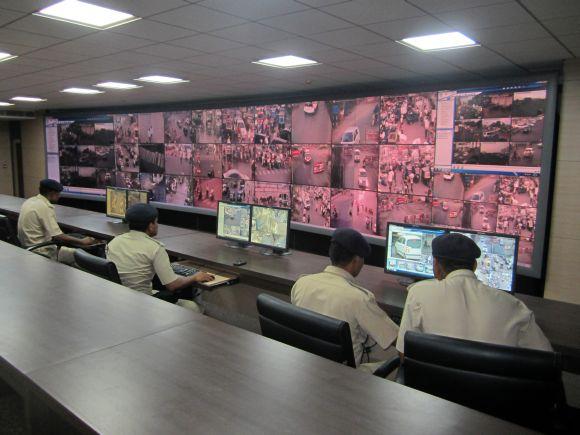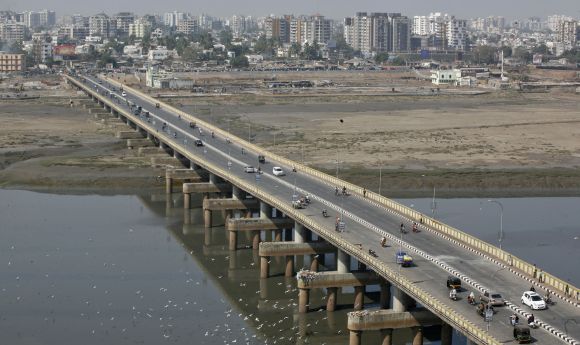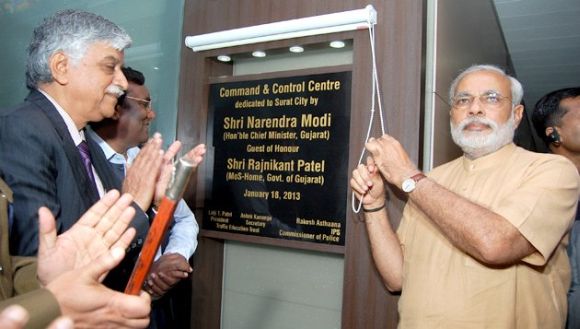
Surat's businessmen and citizens collect funds to help the police build a state-of-the-art surveillance system that will provide real-time video coverage of the city. Sheela Bhatt reports.
In New Delhi, the 'Gujarat model' is a political phrase linked to developmental politics of Gujarat Chief Minister Narendra Modi. But there is no denying the fact that there is a 'Gujarat model' of doing things and it's not necessarily political nor is it about Modi.
Where else but in Gujarat will you find all sort of diamond traders, manufacturers of textiles, importers-exporters of chemicals and bigwigs of the Hazira industrial complex getting together on a common platform, collecting funds worth Rs 10.5 crore, putting it on the table of Surat Police Commissioner Rakesh Asthana and asking him to provide them with a world-class security and surveillance system for the city?
The people of Surat motivated and supported Asthana to build a command and control centre equipped with the state-of-art technology partly imported from Israel and the United States to improve surveillance in the city, to improve safety of its 50 lakh people and have better traffic management.
The command and control room, active 24X7, was inaugurated by Modi in January. A visit to the centre is a unique experience with its state-of-the-art 280-square-foot video wall, bought from Delta Displays, for the first-ever 'safe city project' in India. The video wall is powered with next-gen LEDs beaming video images from the CCTV network spread all over the city.
Please ...

Today Surat has 104 cameras at 23 locations, mainly at entry and exit points, at the airport, railway stations, bus stands, main markets, and at all main traffic junctions. The spots were decided after the survey by a private agency. What is shot in real-time by the high-tech cameras with high density resolutions, provided by Verint Systems, is visible constantly on the huge wall.
Any incidents including roads accidents or crimes are relayed real time to the control centre. The video footage is sent through an optic fibre network, already in place in Surat as it is in most cities of Gujarat. All the cameras are tamper-proof and provide superb clear quality vision and have a range of 1,200-1,500 metres. It can work without power for almost six hours since it has a UPS attached.
All the video footage is stored in IBM machines for one month. So in any crime if police wants to locate movement of criminals or their vehicles, they can go back to the video footage to check and verify. Around 95 cameras are fixed with 36X zoom and the rest are moving cameras that can cover a 360 degree view.
The story started on July 13, 2011 when bomb blasts rocked Mumbai's Zaveri Bazaar, Dadar and Opera House areas where Gujarati diamond merchants were targeted. The blast killed 26 people and injured around 100.
Asthana, being the police commissioner of a city where the diamond trade is flourishing, understood well that if Mumbai can be targeted Surat can't be far behind. Asthana and city's civic society felt strongly that something should be done to ensure that Zaveri Bazaar type of bomb blasts be prevented.
The money collected from various industries and businesses was transferred to the Surat Traffic Education Trust and the Surat police executed the project with help of a local firm.
The tender was won by Surat-based Innovative Telecom & Software, which is expected to implement the five-phase project which will see deployment of 5,000 surveillance cameras at more than 500 locations to cover 150 square km of city. It is a fine example of police-public-private partnership.
The historic city handles more than 85 percent of rough diamonds in the world providing employment to more than 5 lakh people and generating a turnover of over Rs 80,000 crore.
Also Surat supplies synthetic textile to almost the entire India. Asthana says, "Surat has been a top terrorist target for long. I got an excellent response from local people. They came forward to plan out best security for themselves. We have set up the surveillance system with funds entirely from the public."
Please ...

Sanjay Shrivastava, joint commissioner of police, Surat, did the initial survey of how to go about it. And Additional CP V S Jobalia ensured that every paisa of the public money was used judiciously. The job was done on a budget of just Rs 10.5 crore.
The first phase, which was to be completed in 12 months, was done in four months to save money. The command and control room has an ultra-modern fire protection system and steps have been taken against power and software failures. The IBM server has storage capacity of 240 terra bytes.
Under the project, Surat city will have 2D city mapping to help in case of fire, provide physical security and also to measure the water levels, and in case of a disaster, help excavation plans.
Asthana says, "The city has 47.38 percent Gujaratis from various districts and 46.56 percent of the people have migrated here from outside Gujarat. The original Surtis are just 6.06 percent."
Crime rate is higher in a city of migrants. Real estate related crimes are increasing and worrisome. The biggest blessing of Surat is its biggest problem too. It's a city where one can get a job easily.
But in just the last decade population has increased by 62 percent. A city with 50 lakh people scattered on 326 square kms is a nightmare for any policeman.
Once Surat was a peaceful and food-crazy city. Old Surtis were jovial, happy-go-lucky and die-hard foodies.
Please ...

But the new Surat of migrants is industrious, focused on money and prosperity and is solution-oriented. Along with prosperity came insecurity, crime and fear. That has created the unavoidable necessity of having better surveillance and security.
The result is here to see at the city police headquarters where five policemen are monitoring Surat round the clock through the camera lenses. They can feed the system with photographs of suspected criminals and terrorists too.
The system recognises the faces once fed into it. If the suspects on the police list enter the city or exit and the camera 'catches' them on screen, the system alerts the police.
The entire exercise is designed to be battle ready if a Mumbai-type terrorist attack takes place in Surat. The command and control system area has one special designated room for emergency conferences. The room has a screen which will provide real time footage for the decision-makers of elite anti-terror forces in case of an emergency.
Asthana says, "It's a very good tool in hands of my men." The detection of traffic violations has increased manifold. More than 600 chalans(...

As Modi said in his inauguration speech, Surat has got a 'third eye' now.
The city that thrives on growth-oriented thinking, fast living, ambitious lifestyle and hyper-consumerism is in position to fight insecurity now at cost of its privacy.
These days, when Surti-lala, as locals are called in desi parlance, step out of their homes, the 'third eye' follows them. If you are in Surat, Asthana has ensured there is no escaping it.
...